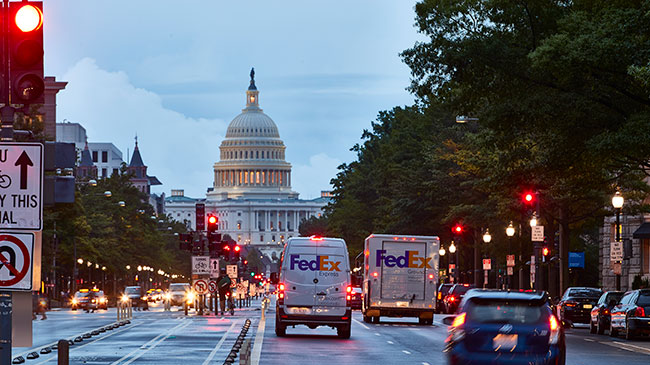
How to ship to India
India has strict customs rules that can lead to delays if not followed properly. That's why it's important to check regulations and ensure the right documents are ready before sending a parcel to India.
What documents do I need to provide when shipping to India?
Along with the commercial invoice and air waybill, you also need to provide the receiver’s KYC documentation in advance. If you’re sending high-value or regulated goods, then you might need to provide extra paperwork.
Shipping paperwork can exist in both physical and digital formats. Shipments to India need to be accompanied by printed copies of documents.
Commercial invoice
All information on the commercial invoice needs to be accurate and in English. The receiver’s details must be exactly the same as on the KYC documents.
All costs on the commercial invoice must be in a currency approved by Indian customs like the rupee, dollar, pound or euro. Make sure there are no spelling mistakes or incorrect abbreviations as this can cause delays. For more information see ‘How to fill in a commercial invoice’.
What is KYC documentation?
KYC stands for ‘Know Your Customer’. This documentation is extremely important when sending packages to India as customs authorities need it to confirm the receiver's identity and address. This applies to both businesses and private individuals.
How does the KYC process work?
Before you ship to a new address in India, the receiver needs to gather their KYC proof and give it to your carrier. The carrier will save the receiver’s details in their KYC database for future shipments to the same address.
This process must be repeated each time you use a different carrier, send goods to a new address or when the receiver’s details change. Even if a business has several addresses, each location must be registered separately in your carrier’s KYC database.
How can the receiver submit KYC documents?
Each carrier has their own process for gathering KYC documents. If you’re using FedEx as a carrier, the receiver can follow these steps:
- The shipper needs to ensure
- That the receiver’s name and address on the Commercial Invoice (C.I.) and Airway bill (Awb) – match the KYC documents going to be submitted by receiver.
- Ensure no “Pet Names”, “Short names”, “Department names” etc. are not mentioned on Awb and C.I.
- The receiver’s phone number and email must also be correct so that the receiver can be contacted directly.
- Send the Airway bill information to the receiver as soon as the shipment is shipped with the link website – https://kyc.fedex.com
- The receiver needs to fulfill the KYC obligation by doing the following steps.
- Obtain his shipment Tracking number (Airway bill number- i.e. AWB) from shipper.
- Visit our website- https://kyc.fedex.com
- Use the options and Job-aids given to fulfill the KYC obligation for his shipment.
- In case of any issues faced by receiver, they can write to india@fedex.com or kycdocs@fedex.com for support.
This Job-Aid page offers a step-by-step guide to filling in the KYC form. It also lists the supporting documents required. Answers to many of the queries regarding KYC documents can be found on the FedEx KYC Frequently Asked Questions (FAQs) page.
What if the receiver’s KYC documents aren’t ready?
Missing KYC documentation not only delays your shipment, but can also lead to penalty fees. To ensure a smooth process, ask your receiver if their KYC details are already known by the carrier. If not, ask your receiver to gather their documents to be submitted before shipping.
Customs clearance in India
When a parcel enters India, it goes through either express or formal customs clearance.
Express clearance
Express clearance, or courier mode, is a streamlined process with minimal paperwork for low-to-medium-value goods such as gifts, samples or documents. With correct paperwork you can expect your parcel to be released the same day.
Formal clearance
Formal clearance, or freight mode, is used for high-value, bulk or regulated goods. This process requires advance payment of duties, additional paperwork, and a customs broker to oversee the clearance process. The receiver can choose to use their own broker, or a broker provided by the carrier.
Find out which process applies to your shipment, so you can prepare the right documents beforehand.
Express and formal customs clearance in India
Express clearance |
Formal clearance |
|
|---|---|---|
Shipment types and values |
|
|
Required documentation |
|
|
Do I need to provide additional documents for Indian customs clearance?
Yes, additional documents are often required for formal clearance and sometimes express clearance (e.g. packing list, purchase order). Other documents you may need to provide, depending on your shipment, are:
- If the shipment has more than one box – a signed packing list
- If the shipment contains a purchase by a private individual (e.g. webshop order) – a purchase order as proof of payment
- Goods sent free of charge to the receiver may require proof of value
- If not already included in the KYC documentation – receiver’s BIN (Bank Identification Number), industrial license, company registration certificate, special import license and/or power of attorney for their broker
- A copy of the receiver’s Import Export Code (IEC) registration issued by the Directorate General of Foreign Trade (DGFT) – the receiver provides this code on the KYC form, however Indian customs authorities often require a copy of the IEC registration as well
- When using a customs broker for formal clearance, the broker will also need to arrange – a formal bill of entry, an import or GATT Declaration, and proof of advance payment of fees such as import duties, D.O. charges, warehouse costs or Octroi regional delivery fees
- If extra proof of the shipment value is requested by the customs authorities during clearance – a separate price list of the goods in the shipment and/or a bank statement from the receiver, stamped by the bank, showing the receiver’s payment for the shipped goods
- If the receiver is located outside Mumbai – a signed and stamped Non-objection Form (N-Form)
To avoid customs delays, the receiver should email the required documents to the sender to print and include in the shipping paperwork.
Finally, make sure you check the Indian regulations that apply to your product before shipping, as they’re frequently updated.
Shipping regulated goods to India? See the list below for a detailed guide on what documentation you need to provide.
What are you shipping to India?
What are the general requirements to ship apparel to India?
- Apparel can generally be imported without any import permit or license, but anti-dumping duties may be imposed to protect India’s local textile and clothing industries
What documents does the sender need to provide?
- An air waybill
- A commercial invoice
- A packing list
What documents does the receiver need to provide?
- KYC documentation – for first shipment with the carrier
- An import permit may be required if the apparel contains exotic animal materials and is subject to the CITES agreement (e.g. snakeskin leather boots)
What details need to be included in the goods description?
- The type of apparel or clothing (e.g. shirt, skirt, T-shirt)
- The fabric type and composition (e.g. 100% cotton jersey)
- The fabric construction (e.g. woven, knit, non-woven)
- Who the clothes are made for (e.g. women, men, children, baby, unisex)
- Price per unit, total value and weight (e.g. 5 T-shirts each US$50, total value US$250, total weight 750g)
What are the general requirements to ship biologics to India?
- If the biologics are of human origin and are for medical purposes such as treatment or diagnosis, they must comply with regulations overseen by India's Ministry of Health and Family Welfare
- If the biologics are of human origin and are for pharmaceutical purposes such as drug or vaccine development, they must comply with regulations overseen by India’s Central Drugs Standard Control Organization (CDSCO)
- If the biologics are of animal origin, they must comply with regulations overseen by the trade unit of the DADF (Department of Animal Husbandry, Dairying and Fisheries)
What documents does the sender need to provide?
- An air waybill
- A commercial invoice
- A packing list
- A Material Safety Data Sheet (MSDS) – with details of any chemical substances, their potential hazards and relevant handling instructions. The MSDS is also required for any chemicals used to preserve biologics, as they may be classified as dangerous goods.
What documents does the receiver need to provide?
- KYC documentation – for first shipment with the carrier
- An import permit – for pharmaceutical products, health-related goods and products of animal origin
What are the general requirements to ship cosmetics to India?
- To import cosmetics into India for commercial purposes the product must comply with health and safety regulations set out by India's Ministry of Health and Family Welfare
- Businesses importing cosmetics into India must be registered with the Central Drugs Standard Control Organization (CDSCO)
- All cosmetic products that are imported for sale into India also need to be registered with the CDSCO. This can be done online.
What documents does the sender need to provide?
- An air waybill
- A commercial invoice
- A packing list
- A declaration stating the cosmetics conform to Indian standards
- A Material Safety Data Sheet (MSDS) – with details of any chemical substances, their potential hazards and relevant handling instructions. The MSDS is also required for any chemicals used to preserve cosmetics, as they may be classified as dangerous goods.
What documents does the receiver need to provide?
- KYC documentation – for first shipment with the carrier
- A registration certificate for Import of Cosmetics issued by the CDSCO
What are the general requirements to ship electronics to India?
- All electronic and IT products imported into India must be registered with the Bureau of Indian Standards (BIS), before being shipped. The registration, or certification process includes product testing by BIS-recognized laboratories.
- Second-hand and used electronic goods imported into India are restricted and subject to license regulations from the Directorate General of Foreign Trade (DGFT) and Ministry of Environment and Forests (MoEF)
What documents does the sender need to provide?
- An air waybill
- A commercial invoice
- A packing list
- A Material Safety Data Sheet (MSDS) – for electronic products containing batteries, as they may be classified as dangerous goods. The MSDS must list details of any chemical substances, their potential hazards and relevant handling instructions.
What documents does the receiver need to provide?
- KYC documentation – for first shipment with the carrier
- Proof of the product’s BIS certification
What are the general requirements to ship food to India?
- To be able to import food, the receiver must obtain a Food Business Operator (FBO) license with the Food Safety and Standards Authority of India (FSSAI)
- Food items shipped to India must have at least three months or 60% of their shelf life remaining after their customs release date. The shorter of the two periods can be accepted. This also applies to food samples.
- Milk and milk products from China are prohibited, including chocolate, chocolate products, candies and confectionery
What documents does the sender need to provide?
- An air waybill
- A commercial invoice
- A packing list
What documents does the receiver need to provide?
- KYC documentation – for first shipment with the carrier
- Proof of their FBO license from the FSSAI
- An import permit from the FSSAI
Shipping requirements and documentation may vary between carriers. This website is designed to provide general information related to shipping. If you’re unsure of the shipping requirements that apply to you, check with your carrier. Make sure to check the rules and regulations of the country you’re shipping from and to prior to shipping. You can find this information on government websites.


